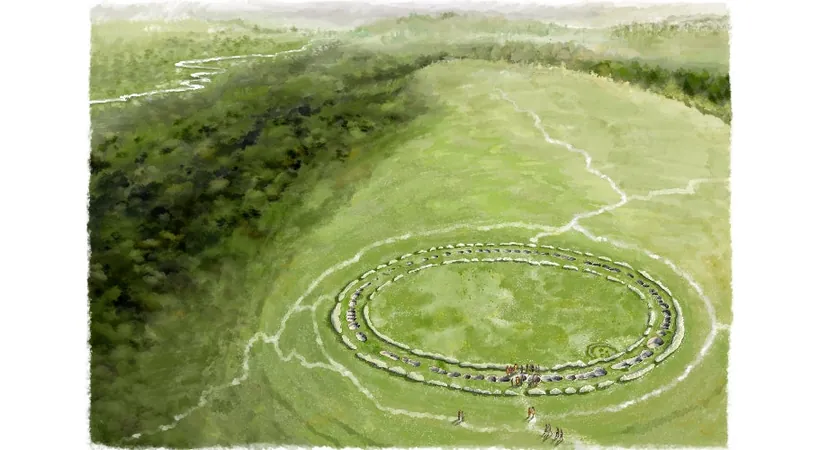
Ancient Circular Burial Site Predates Stonehenge, Shaping History
2025-04-12
Author: Siti
A groundbreaking discovery in the lush hills of southwest Britain has revealed an ancient burial site that predates Stonehenge by centuries. The circular enclosure at Flagstones, located near Dorchester, is now recognized as possibly the oldest of its kind in Britain, forcing a reevaluation of our understanding of Neolithic ceremonial practices.
Revolutionary Findings Rewrite Archaeology
Recent radiocarbon dating has pushed the age of Flagstones back to around 3200 BC—200 years earlier than previously thought. This significant update positions the site as a cornerstone of Middle Neolithic culture, suggesting it may have influenced iconic structures like Stonehenge.
The Emergence of Circular Monuments
From 3400 to 2800 BC, builders in Britain and Ireland transitioned from traditional rectangular structures to expansive circular enclosures—known as proto-henges. These expansive circles, which measure between 80 to 110 meters in diameter, were often surrounded by ditches and banks, signifying a shift in ritualistic practices during their era.
Despite the lack of abundant artifacts, excavations reveal a deep ceremonial significance, with many sites housing cremated remains and carefully interred bodies. This shift toward circular architecture highlights a transformative period in cultural and ritualistic understanding.
Unearthing Flagstones’ Mysteries
The Flagstones enclosure, hidden beneath the former home of novelist Thomas Hardy, went largely unnoticed until its revelation during construction in the 1980s. Archaeologists uncovered a captivating 100-meter-wide circle featuring intercutting pits and evidence of both inner and outer banks.
What makes Flagstones particularly intriguing is its meticulous construction into the chalk bedrock. Burials found at the site, including that of a cremated adult beneath a massive sarsen stone and immured children, speak volumes about its use as a sacred burial ground.
Surprising Radiocarbon Discoveries
Initial assumptions placed the construction of Flagstones around 3000 BC, closely aligning it with early Stonehenge. However, a recent advanced dating initiative by Dr. Susan Greaney from the University of Exeter and her team revealed that initial activity on site dates as far back as 3650 BC, with the enclosure established around 3200 BC.
The most remarkable finding—an adult male grave beneath the sarsen stone—suggests that Flagstones maintained its sacred significance for centuries beyond its initial use.
Flagstones: A Prehistoric Pioneer
Comparisons between Flagstones and other notable sites indicate its unique status and potential as a precursor to Stonehenge. The circular design parallels the first phase of Stonehenge, which was built later around 2900 BC, raising questions about architectural inspiration and the evolution of ceremonial structures.
Connections Across Cultures
The new dating also highlights a broader network of ceremonial spaces across Britain, echoing connections to other sites, such as Llandygái ‘Henge’ A in Wales, which share similarities in burial practices and monument designs. Flagstones may represent a shared cultural lineage that spanned beyond Britain into Ireland, suggesting the exchange of ideas and rituals across communities.
The Importance of Chronology
Establishing an accurate timeline is crucial to understanding Neolithic life and beliefs. With advancements in radiocarbon dating, archaeologists can now more accurately integrate Flagstones into the larger tapestry of cultural shifts that defined prehistoric Britain.
Flagstones bridges notable monuments in the Dorchester area, enhancing our grasp of the transition from linear to circular ceremonial styles.
A Lasting Legacy
Though much of the Flagstones site now lies beneath modern infrastructure, its significance continues to expand. As a scheduled monument, it serves as a focal point for understanding Britain’s ancient past. The ongoing questions it raises about tradition and cultural memory are at the forefront of archaeological exploration.
Thanks to recent research, Flagstones, once considered a mere historical footnote, shines as a pivotal landmark in the narrative of Britain’s prehistoric heritage.




 Brasil (PT)
Brasil (PT)
 Canada (EN)
Canada (EN)
 Chile (ES)
Chile (ES)
 Česko (CS)
Česko (CS)
 대한민국 (KO)
대한민국 (KO)
 España (ES)
España (ES)
 France (FR)
France (FR)
 Hong Kong (EN)
Hong Kong (EN)
 Italia (IT)
Italia (IT)
 日本 (JA)
日本 (JA)
 Magyarország (HU)
Magyarország (HU)
 Norge (NO)
Norge (NO)
 Polska (PL)
Polska (PL)
 Schweiz (DE)
Schweiz (DE)
 Singapore (EN)
Singapore (EN)
 Sverige (SV)
Sverige (SV)
 Suomi (FI)
Suomi (FI)
 Türkiye (TR)
Türkiye (TR)
 الإمارات العربية المتحدة (AR)
الإمارات العربية المتحدة (AR)